Red berries on bushes are always a beautiful sight to behold, although not all of them are safe to eat. The problem is it is very hard to tell at first glance which ones are safe to eat and which ones are not, so it is best to always err on the side of caution.
Keep in mind that you should never eat a red berry from a bush unless you are completely sure what kind of red berry it is.
Here are 15 types of red berries on shrubs that you should familiarize yourself with.
1. Redcurrant Berry
Redcurrant berries grow on a bush that grows to between three and five feet tall on average. The leaves are light green with five pointed lobes.
The berries that grow on redcurrant bushes are bright red, almost translucent in appearance, and are no bigger than half an inch around.
Redcurrant berries are edible and possess a semi-sweet tart flavor that does well in jams and garnishes.
They are extremely healthy berries, containing both vitamin C and K, as well as a significant amount of potassium.
2. Hobble Bush Berry
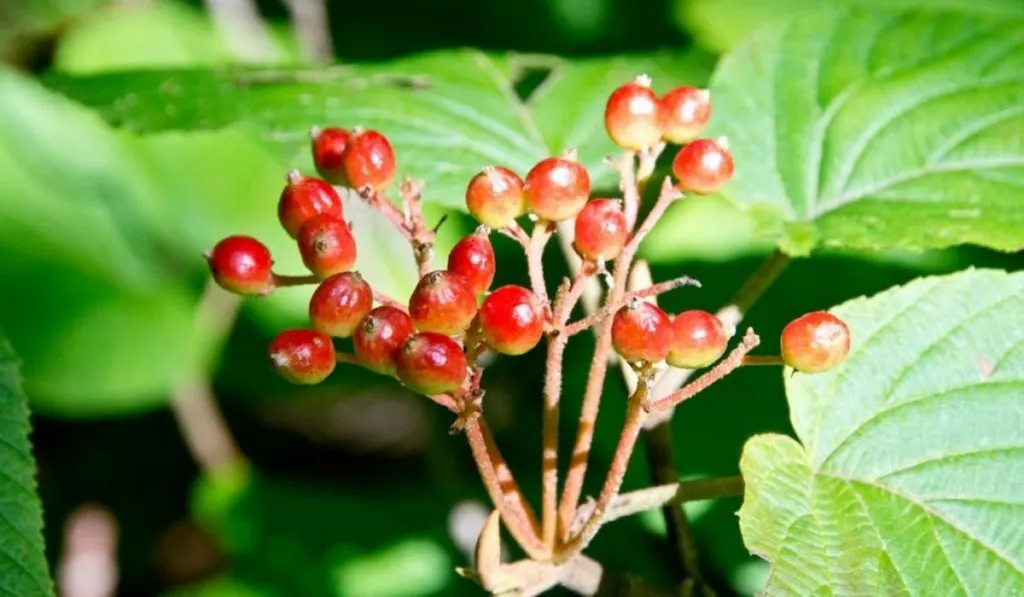
Hobblebush berries are the red fruit produced by the hobblebush itself, which can grow up to 12 feet high. The berries start off red but turn to black as they ripen.
Hobblebush berries are edible and are most often turned into jelly. The berries are red, small, round, and only grow to about a third of an inch in diameter.
Hobblebushes can be found in North America, typically in the eastern part of the country, and tend to be found near water sources like streams and swamps.
3. Winterberry
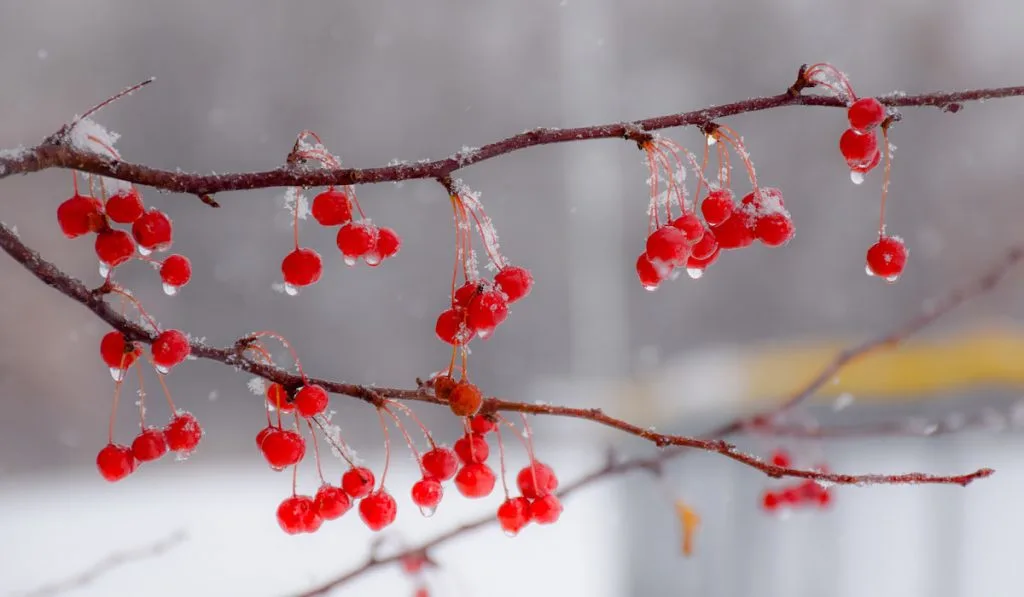
Winterberries grow on winterberry plants which, though deciduous, are still part of the Ilex, or holly family. They can be found most often in the eastern parts of North America. Winterberry shrubs can grow to between three and 16 feet tall.
The round red winterberries can grow to about .31 inches in diameter. They can range in color from bright red to an orange-red shade depending on the variety.
Red winterberries are not considered to be edible for humans and, like other holly berries, they are toxic. They contain saponin, which is known to cause severe stomach distress and other issues.
4. Butcher’s Broom Berry
Butcher’s broom berries grow on an evergreen bush known as the butcher’s broom. It is not native to North America, but it was introduced here and is known to grow best in the lower half and far western part of the country.
The red berries produced on the butcher’s broom bush are non-edible for humans, but birds do tend to enjoy them. They are round as well as rather large for bush berries in genera,l and they closely resemble cherry tomatoes.
The bush can grow up to 54 inches tall and the berries will be visible at the end of summer or the early part of fall.
5. Raspberry
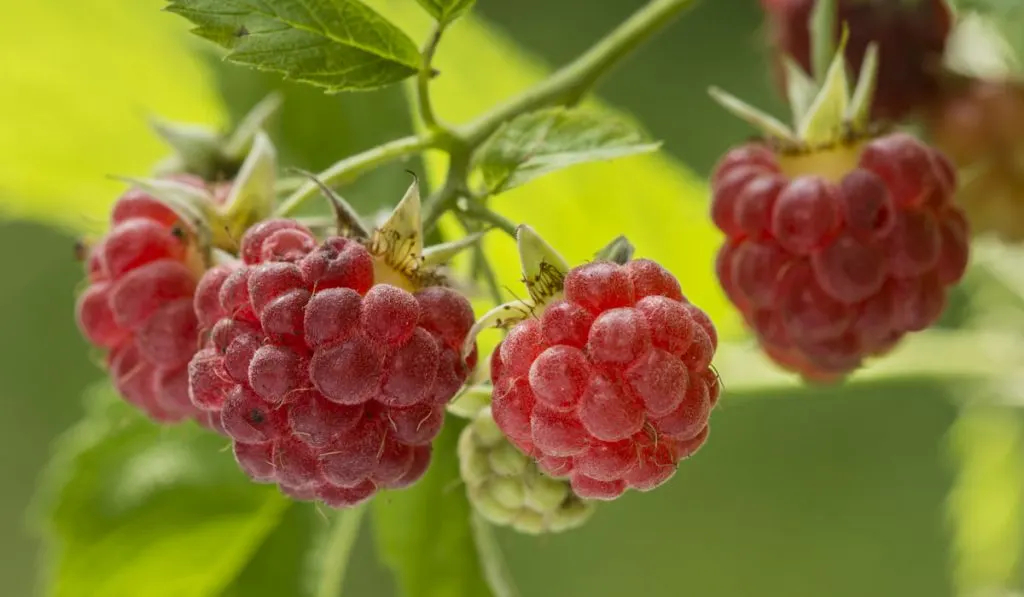
Raspberries are some of the most well-known red berries that grow on bushes and they have more than earned their place on our list.
Raspberries are edible and are easily recognizable thanks to their strawberry-like shape and the individual cells that encapsulate their juice.
Raspberries bushes are found all over North America and tend to be very hardy and persistent plants. Raspberries are very healthy for humans and contain fiber, vitamin C, and a low sugar content.
6. Red Chokeberry
Red chokeberries are bushes that produce small red berries in the middle and eastern portions of North America. They can grow up to 10 feet tall and 6 feet wide.
The berries of the red chokeberry bush are edible but they are not very appetizing and they tend to be bitter. They are most often used to make jam or jelly and are rarely, if ever, eaten raw.
Red chokeberry fruit is very small, round, and deep red. They are hard to the touch and grow in small clusters on the plant.
7. Japanese Barberry
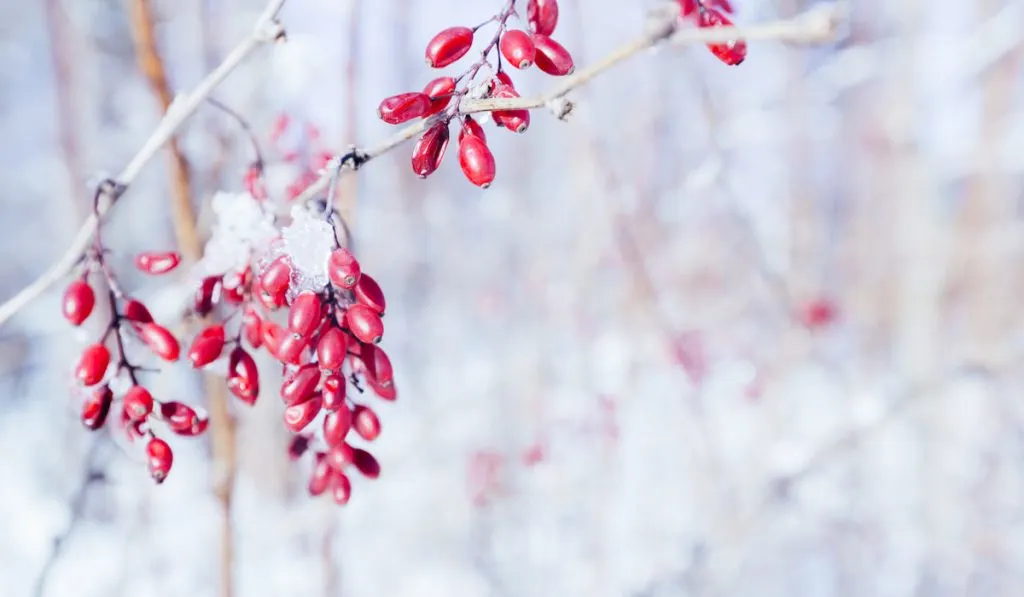
Japanese barberry bushes grow throughout a large part of the United States and they produce vibrant red berries. The bush itself can grow up to six feet tall and seven feet wide.
The red Japanese barberry fruit is considered edible by some, although it is not regularly eaten and often not recommended. These berries not only contain highly toxic properties but are said to cause diarrhea when eaten.
The barberries are small and oval-shaped with a deep red color that is most prominent during the summer and fall. Most ecologists recommended steering clear of barberry bushes since they tend to attract Lyme-causing deer ticks.
8. Tatarian Honeysuckle
The Tatarian honeysuckle bush can grow up to an impressive 9.8 feet tall. The berries produced on this bush can range from orange to bright red in color.
Tatarian honeysuckle berries are considered to be non-edible for humans. They are not inherently toxic or poisonous, however, they can cause uncomfortable gastric upset when consumed.
The berries on this bush are tiny and red when ripe, often growing to only a quarter of an inch in diameter.
9. Elderberry
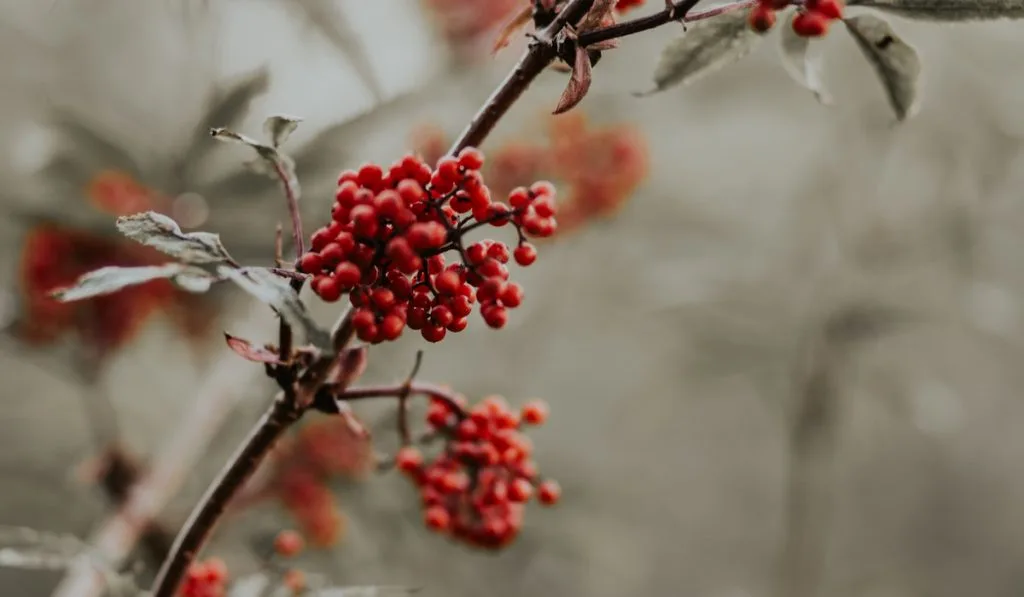
Elderberry bushes produce berries that can be either black, bluish-black, or gorgeous red color all over the United States. Red elderberries are small red berries that grow in large clusters on this bush.
Red elderberries, like all elderberries, are considered extremely toxic in their raw form because they contain cyanogenic glycosides.
These berries are not considered edible when raw but can be consumed in various forms once they have been properly cooked.
Eating fresh elderberries, regardless of their color, can cause cramping, diarrhea, and other gastric disorders in humans.
10. Nandina
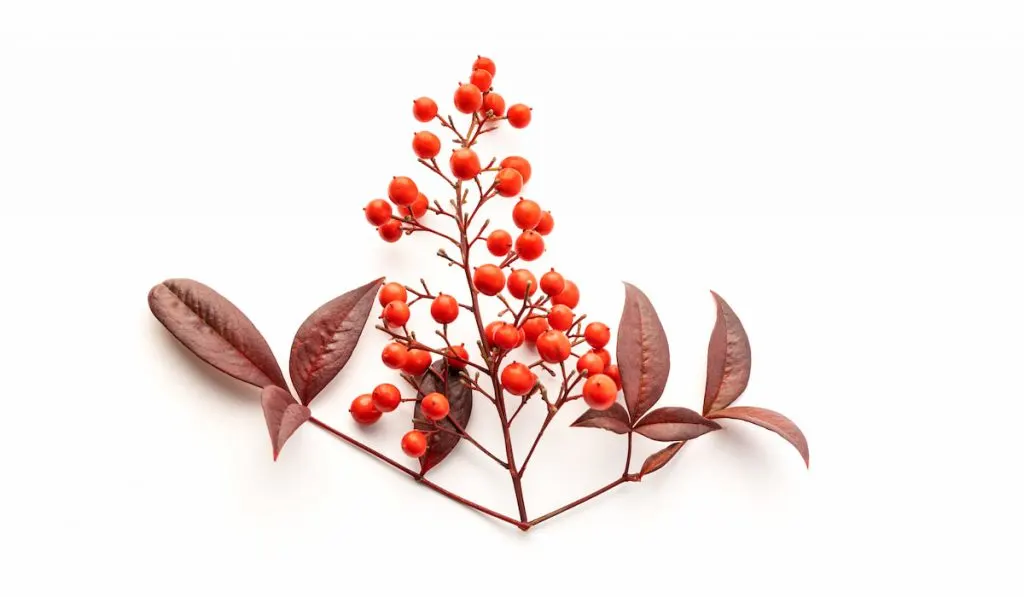
Nandina, also called sacred bamboo, are commonly found in North America, especially in North Carolina, Tennessee, and Georgia. It can grow up to 8 feet tall and produces red berries.
Nandina berries are small, red, round, and tend to grow in large clusters on the plant.
These berries are non-edible because they contain hydrogen cyanide-producing properties that have the potential to be fatal when consumed in large quantities.
11. Spindle Berry
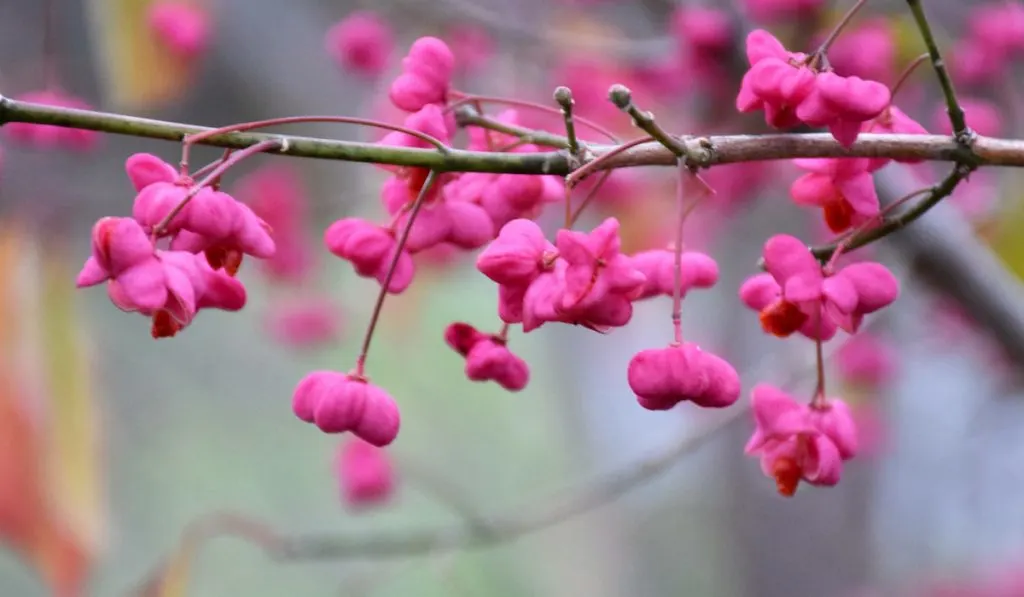
Spindle berries grow on the spindle bush and can range in color from pink to purple to red. The spindle bush can grow to a shocking 20 feet tall in the right conditions.
The berries on the spindle berry bush can be red in color but regardless of the color, they are considered non-edible for humans. The berries are poisonous and can cause liver damage as well as kidney disorders that can prove fatal in humans.
Spindle plants are common in North America, although like other poisonous berry-producing plants, they are considered invasive because they have no natural animal predators.
12. Buffaloberries
The buffaloberry bushes can be found most often in the western and central parts of North America and they produce beautiful red berries. There are three different kinds of buffaloberry bushes include the silver buffaloberry, the Canada buffaloberry, and the roundleaf buffaloberry bush.
The berries on the buffaloberry bush are small, round, and dark red with tiny white spots. They are considered edible for humans as well as animals including, but not limited to, deer, bears, and birds.
Buffaloberry fruit is sweet and sour, making them ideal for jellies, jams, and sauces.
13. Bittersweet Nightshade
The bittersweet nightshade is actually a vine, not a bush, but it is an invasive vine that often grows in and around bushes. This unique attribute makes it appear that the vine is a natural part of the bush when it is not.
The berries that are produced on this vine are small, oval-shaped red berries that are only about a centimeter in length.
Bittersweet nightshade berries are very poisonous to humans and are considered non-edible.
The problem is that these berries look and even smell a little bit like tiny tomatoes, but it is important to steer clear of them altogether.
14. Cotoneaster
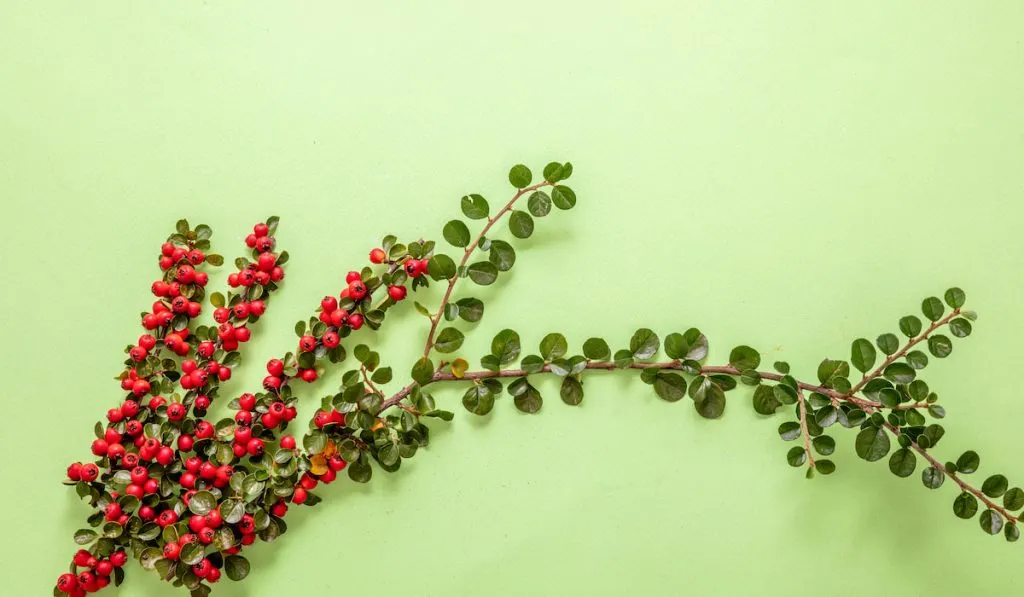
Cotoneaster bushes can be found in North America and they produce small berries that can be pink, orange, black, or red. They are popular in gardens and landscaping.
Cotoneaster bushes may be attractive, but the berries they produce are non-edible. In large amounts, they can be very toxic and can cause respiratory distress and muscle weakness.
They are round, sometimes red, and can grow anywhere between a quarter of an inch to 3 inches in diameter depending on the variety.
15. Red Berry Mistletoe
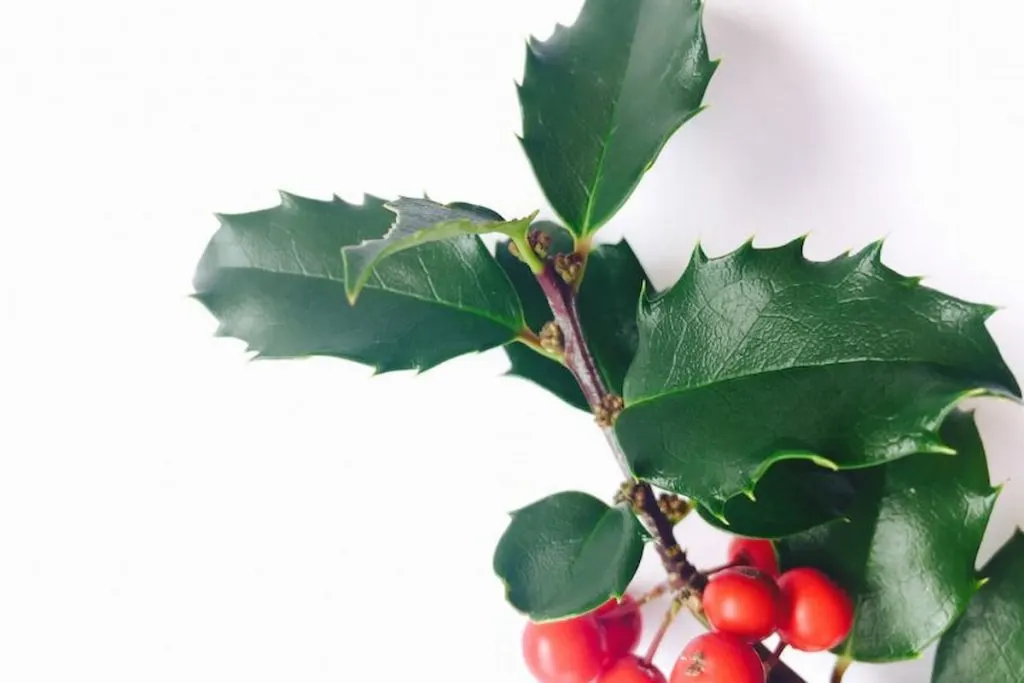
Mistletoe is a hemiparasitic plant, which means it latches onto other bushes and trees for its survival. There are more than 70 different mistletoe species in existence, some of which produce gorgeous red berries.
These are the same mistletoes that are used during Christmastime to invoke affection, however, it is important to understand that they are extremely poisonous. The red berries, or any color of berries for that fact, that are produced by mistletoes are non-edible.
These berries, when eaten, can lead to slowed pulse rates and painful gastric distress. They even contain a substance called lectin viscumin which can prevent protein absorption, something that can be very dangerous to humans.
Final Thoughts
It is good to now know that there are so many bushes in America that produce red berries, some of which can be very poisonous to humans. It is important to remember never to consume any red berries from any plant unless you are 100% sure what kind of berry they are and that they are edible.
Resources:
Learning about all the different types of red berries on bushes was a real educational experience that taught me more than I could have imagined. Here are the sources that I used to write this article.
- https://en.wikipedia.org/wiki/Redcurrant
- https://en.wikipedia.org/wiki/Viburnum_lantanoides
- https://en.wikipedia.org/wiki/Ilex_verticillata
- https://en.wikipedia.org/wiki/Ruscus_aculeatus
- https://garden.org/plants/view/706584/Butchers-Broom-Ruscus
- https://en.wikipedia.org/wiki/Raspberry
- https://plants.ces.ncsu.edu/plants/aronia-arbutifolia
- https://extension.psu.edu/japanese-barberry
- https://en.wikipedia.org/wiki/Lonicera_tatarica
- https://en.wikipedia.org/wiki/Sambucus
- https://plants.ces.ncsu.edu/plants/nandina-domestica
- https://en.wikipedia.org/wiki/Nandina
- https://en.wikipedia.org/wiki/Euonymus_europaeus
- https://www.ag.ndsu.edu/trees/handbook
- https://en.wikipedia.org/wiki/Shepherdia
- https://en.wikipedia.org/wiki/Solanum_dulcamara
- https://en.wikipedia.org/wiki/Cotoneaster
- https://en.wikipedia.org/wiki/Viscum
